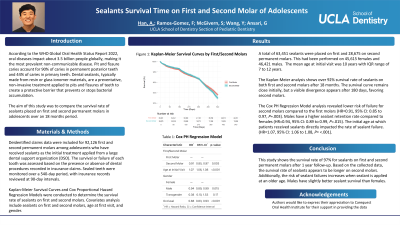Preventive
331 - Sealants Survival Time on First and Second Molars of Adolescents

- AH
Alexander Han, DMD
Resident
University of California, Los Angeles
University of California, Los Angeles
Los Angeles, California, United States - GA
Ghassem Ansari, D.D.S., M.Sc., Ph.D., A.P.P.D
Clinical Professor
University of California, Los Angeles
Los Angeles, California, United States - SM
Sean McGivern, D.D.S., M.P.H.
University of California, Los Angeles

Francisco J. Ramos-Gomez, D.D.S., M.S., M.P.H.
Professor of Pediatric Dentistry
University of California, Los Angeles
UCLA School of Dentistry
Los Angeles, California, United States
Yan Wang, PhD (she/her/hers)
Assistant Professor
University of California, Los Angeles
Los Angeles, California, United States
Francisco J. Ramos-Gomez, D.D.S., M.S., M.P.H.
Professor of Pediatric Dentistry
University of California, Los Angeles
UCLA School of Dentistry
Los Angeles, California, United States- GA
Ghassem Ansari, D.D.S., M.Sc., Ph.D., A.P.P.D
Clinical Professor
University of California, Los Angeles
Los Angeles, California, United States
Presenting Author(s)
Co-Author(s)
Research Mentor(s)
Program Director(s)
Purpose: This study aims to compare the survival rate of sealants placed on first and second molars of adolescents over 18 months.
Methods: Deidentified claims data were included for 92,126 first and second molars among adolescents who have received sealants as the initial treatment applied from a large dental support organization (DSO). Kaplan-Meier Survival Curves and Cox Proportional Hazard Regression Models were conducted to determine the survival rate of sealants on first and second molars. Covariates analysis include sealants on first and second molars, age at first visit, and gender.
Results:
A total of 63,451 sealants were placed on first molars, while 28,675 on second permanent molars in 45,615 females and 46,421 males. Mean age at initial visit was 10 years old with IQR range of 7 to 12 years old. The Kaplan-Meier analysis shows over 92% survival rate of sealants on both 1st and 2nd molars after 18 months. The analysis revealed lower risk of failure for second molars compared to the first molars (HR=0.91, 95% CI: 0.85 to 0.97, P=.003). The rate of sealant failure was increased with age among this group (HR=1.07, 95% CI: 1.06 to 1.08, P= < .001).
Conclusion:
This study shows the survival rate of 97% for sealants on first and second molars after 12 months. The survival rate of sealants on second molars are higher than first molars. As the risk of sealant failures increases by age, early dental visits and sealant placement at an younger age is paramount.
Identify Supporting Agency and Grant Number:

.jpg)